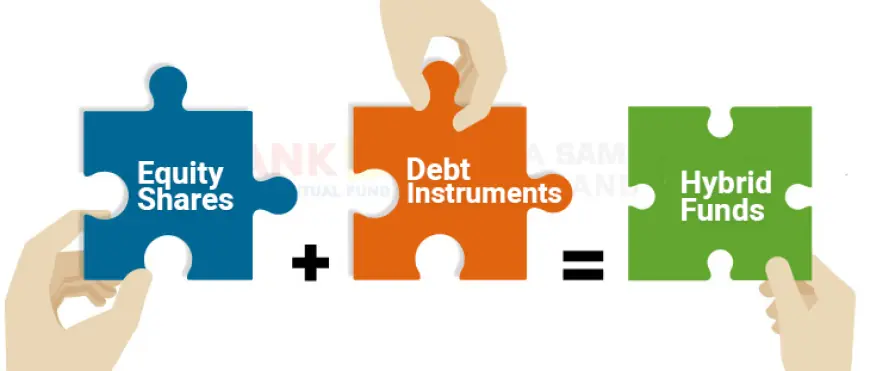Mutual Fund Types Explained: Equity, Debt, and Hybrid
Learn the differences between equity, debt, and hybrid mutual funds. Understand risks, returns, tax rules, and how to use a lumpsum calculator effectively.

Mutual funds have become a widely accepted investment avenue for Indian investors. They offer a flexible and diversified way to invest across asset classes, depending on one’s financial goals and risk profile. However, before investing, it is important to understand the types of mutual funds available—particularly equity, debt, and hybrid funds.
Each type has its own features, potential benefits, and suitability depending on your time horizon and financial needs. In this article, we will break down the key types of mutual funds, and explore how tools like a lumpsum calculator can help you estimate the potential growth of a one-time investment.
What is a mutual fund?
A mutual fund is a professionally managed investment scheme that pools money from multiple investors and invests in a portfolio of financial instruments such as equity shares, bonds, and money market securities.
The pooled money is managed by a fund manager in line with the stated objective of the scheme. The value of each investor’s holding is represented by units, and the price of these units is called the Net Asset Value (NAV), which changes daily based on market conditions.
Why mutual fund types matter for investors
Every investor has unique financial goals—whether it is buying a house, planning for retirement, or building a contingency fund. Each of these goals requires a different investment approach in terms of risk, return potential, and time horizon.
Mutual funds are broadly classified into three categories based on the asset allocation strategy they follow:
-
Equity mutual funds
-
Debt mutual funds
-
Hybrid mutual funds
Let us look at each in more detail.
Equity mutual funds
Equity funds primarily invest in stocks of listed companies. The objective is to offer long-term growth potential through capital appreciation. These funds can be suitable for investors with a longer time horizon and a higher risk tolerance.
Types of equity funds include:
-
Large-cap funds – Invest in companies with large market capitalisation.
-
Mid-cap funds – Target mid-sized companies with moderate growth potential.
-
Small-cap funds – Focus on smaller companies with high growth potential but higher volatility.
-
Multi-cap and flexi-cap funds – Diversify across companies of various sizes.
-
Sectoral or thematic funds – Invest in specific sectors such as healthcare or technology.
Debt mutual funds
Debt funds invest primarily in fixed income instruments such as government bonds, corporate debt securities, treasury bills, and other money market instruments. These funds may suit investors looking for relatively more stable income potential over the short to medium term.
Categories include:
-
Liquid and overnight funds – Suitable for very short-term parking of funds.
-
Short duration funds – A great alternative for investment horizons of one to three years.
-
Corporate bond and banking PSU funds – Invest in high-rated debt instruments.
-
Gilt funds – Invest only in government securities.
Debt funds may carry interest rate risk or credit risk depending on the instruments held. While they are considered relatively lower in volatility than equity funds, any returns are not assured.
Hybrid mutual funds
Hybrid funds invest in a mix of equity and debt instruments. These funds aim to balance the potential for capital appreciation with income generation and are suited for investors seeking moderate risk and diversified exposure.
Types of hybrid funds include:
-
Aggressive hybrid funds – Invest around 65-80% in equities and the rest in debt.
-
Conservative hybrid funds – Allocate more towards debt, usually 75-90%, with a smaller equity portion.
-
Balanced advantage funds – Dynamically adjust allocation between equity and debt based on market conditions.
Hybrid funds are designed to cater to investors who want some equity exposure but are not comfortable with full equity market risk.
When to use a lumpsum calculator
If you are planning a one-time investment in a mutual fund, a lumpsum calculator can help you estimate the potential value of your investment over time. It uses three basic inputs:
-
Investment amount
-
Expected rate of return
-
Investment duration
Factors to consider before choosing a fund type
Selecting the right mutual fund type depends on several factors:
-
Investment goal – Long-term wealth creation, short-term liquidity, retirement corpus, etc.
-
Time horizon – How long you can stay invested
-
Risk appetite – Your comfort with market volatility
-
Income needs – Whether you need regular income or are aiming for potential capital growth
Make sure to review the fund's investment objective, portfolio composition, and historical trends. However, past performance should not be the only deciding factor.
Understanding tax implications
Tax treatment for mutual funds varies based on the type and holding period:
-
Equity funds – Long-term capital gains (holding over one year) above Rs 1.25 lakh in a financial year are taxed at 12.5%.
-
Debt funds – As per current provisions, capital gains are taxed based on your income slab, irrespective of the holding period.
Conclusion
Understanding the key characteristics of equity, debt, and hybrid mutual funds can help you make informed investment decisions. Every fund type has a different role to play in your portfolio. By choosing based on your goals, risk profile, and time horizon, you can structure your investments more effectively. It is advisable to consult with a financial planner or investment advisor before making any investment decisions.
Mutual Fund investments are subject to market risks, read all scheme related documents carefully.
What's Your Reaction?
 Like
0
Like
0
 Dislike
0
Dislike
0
 Love
0
Love
0
 Funny
0
Funny
0
 Angry
0
Angry
0
 Sad
0
Sad
0
 Wow
0
Wow
0


















































